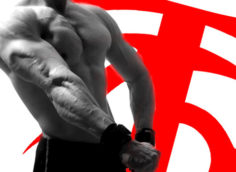The shoulder is a ball and socket joint which allows for incredible range of motion. Unfortunately, this comes at the price of decreased stability which makes your shoulder one of the most finicky joints in the body.
If you don't have proper motor control of your upper back musculature, and your shoulder blades are unable to move freely around your ribcage, you'll be in a continuous cycle of tweaking and reinjuring your shoulder.
Try out the following banded exercises to stabilize your shoulders, free up your shoulder blades, and mobilize your T-spine so that you can train pain-free.
This is awesome for strengthening the rotator cuff as well as teaching your body how to properly retract your shoulder blades and tuck your elbows during the eccentric portion of an upper-body pressing exercise.
Although you could do these with the band in front of the body, putting it behind the back will allow for better retraction of the shoulder blades. It'll also allow the head of the humerous to sit better in the socket of the joint due to the extra external rotation put upon the shoulder.
Begin with your elbows tucked into your sides and shoulders retracted so that you make a "W" with your arms and upper body. Stretch the band as you straighten your arms out so that they make a "T."
Focus on keeping continuous tension on the band and maintaining external rotation of the shoulder so that your shoulder sits naturally in its socket.
This is great for freeing up your shoulder blades as well as activating your anterior delts. Start with your arms straight and palms in a neutral position. Try to touch your pinkies together so that your palms are up when your arms are out in front of you.
Keep your core tight and focus on rounding your upper back to create a "hollow chest." This will allow you to maximize the amount of movement you get through your shoulder blades and get more T-spine mobility.
This exercise combines the "W" press and the banded flye creating more time under tension and one serious burn. Do 10 behind the back "Ws" and 10 banded flyes to groove a good movement pattern before trying to combine them.
This is similar to a vertical band pull-apart, but it allows for more vertical overhead motion since your movement arm starts right next to your head. This will fire up your lats and allow you to achieve full scapular upward rotation and elevation due to the vertical starting position of your moving arm.
Start by positioning your movement arm with your biceps next to your ear and your stationary arm out to the side so that tension is placed on the band. Keep your stationary arm still and elbow straight as you pull your moving arm away from your head.
Not every upper-body press or pushing exercise will have a perfect bar path. Having the ability to stabilize your shoulders overhead from a variety of different angles is critical to keeping them healthy and strong.
Banded diagonal pulls prepare the rotator cuff and upper back to stabilize the shoulder from a variety of angles. This prevents the shoulder from "tweaking" if it gets slightly out of position.
Keep both elbows straight and engage your core so that your lower back doesn't excessively arch when pulling. Make sure you have both thumbs facing away from the body so that your shoulders can go more naturally into external rotation as you pull the band apart.




